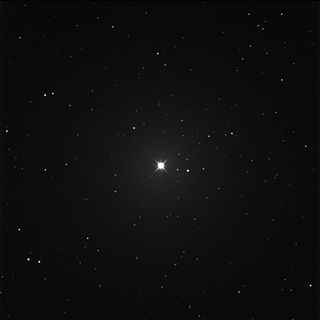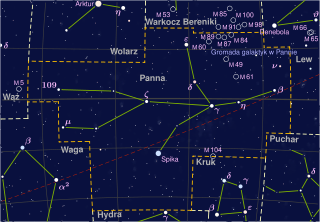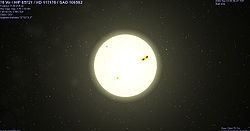
Eta Cassiopeiae is a binary star system in the northern constellation of Cassiopeia. Its binary nature was first discovered by William Herschel in August 1779. Based upon parallax measurements, the distance to this system is 19.42 light-years from the Sun. The two components are designated Eta Cassiopeiae A and B.

61 Virginis is the Flamsteed designation of a G-type main-sequence star (G7V) slightly less massive than the Sun, located 27.8 light-years away in the constellation of Virgo. The composition of this star is nearly identical to the Sun.
HD 114729 is a Sun-like star with an orbiting exoplanet in the southern constellation of Centaurus. Based on parallax measurements, it is located at a distance of 124 light years from the Sun. It is near the lower limit of visibility to the naked eye, having an apparent visual magnitude of 6.68 The system is drifting further away with a heliocentric radial velocity of 26.3 km/s. The system has a relatively high proper motion, traversing the celestial sphere at an angular rate of 0.373″·yr−1.
HD 114783 is a star with two exoplanetary companions in the equatorial constellation of Virgo. With an apparent visual magnitude of 7.56 it is too faint to be visible with the unaided eye, but is an easy target for binoculars. Based on parallax measurements, it is located at a distance of 68.6 light-years from the Sun, but is drifting closer with a radial velocity of −12 km/s.
HD 210277 is a single star in the equatorial constellation of Aquarius. It has an apparent visual magnitude of 6.54, which makes it a challenge to view with the naked eye, but it is easily visible in binoculars. The star is located at a distance of 69.6 light years from the Sun based on parallax, but is drifting closer with a radial velocity of −20.9 km/s.

109 Virginis is a single, white-hued star in the zodiac constellation of Virgo, located some 134.5 light years away from the Sun. It is the seventh-brightest member of this constellation, having an apparent visual magnitude of +3.72.

Chi Virginis is a double star in the constellation Virgo. Based upon parallax measurements, it is approximately 315 light-years from Earth. It has an apparent visual magnitude of 4.65, which is bright enough to be seen with the unaided eye under suitable viewing conditions.
HD 142 is a wide binary star system in the southern constellation of Phoenix. The main component has a yellow-white hue and is dimly visible to the naked eye with an apparent visual magnitude of 5.7. The system is located at a distance of 85.5 light years from the Sun based on parallax measurements, and is drifting further away with a radial velocity of +6 km/s.
Lambda Geminorum, Latinized from λ Geminorum, is a candidate multiple star system in the constellation Gemini. It is visible to the naked eye at night with a combined apparent visual magnitude of 3.57. The distance to this system is 101 light years based on parallax, and it is drifting closer with a radial velocity of –7.4 km/s. It is a member of what is suspected to be a trailing tidal tail of the Hyades Stream.
HD 125612 is a binary star system with three exoplanetary companions in the equatorial constellation of Virgo. It is too dim to be visible to the naked eye, having an apparent visual magnitude of 8.31. The system is located at a distance of 188 light years from the Sun based on parallax measurements, but it is drifting closer with a radial velocity of −18 km/s.
HD 222582 is a multiple star system in the equatorial constellation of Aquarius. It is invisible to the naked eye with an apparent visual magnitude of 7.7, but can be viewed with binoculars or a small telescope. The system is located at a distance of 137 light years from the Sun based on parallax, and it is drifting further away with a radial velocity of +12 km/s. It is located close enough to the ecliptic that it is subject to lunar occultations.
36 Ursae Majoris is a double star in the northern constellation of Ursa Major. With an apparent visual magnitude of 4.8, it can be seen with the naked eye in suitable dark skies. Based upon parallax measurements, this binary lies at a distance of 42 light-years from Earth.
HD 158633 is a main sequence star in the northern constellation of Draco. With an apparent visual magnitude of 6.43, this star is a challenge to view with the unaided eye but it can be seen clearly with a small telescope. Based upon parallax measurements, it is located at a distance of around 42 light years from the Sun. The star is drifting closer to the Sun with a radial velocity of −39 km/s, and is predicted to come to within 26.5 ly (8.1 pc) in around 190,400 years.
Gliese 806 is a star in the northern constellation of Cygnus, located about a degree to the southeast of the bright star Deneb. It is invisible to the naked eye with an apparent visual magnitude of +10.79. The star is located at a distance of 39.3 light years from the Sun based on stellar parallax. It is drifting closer with a radial velocity of −24.6 km/s, and is predicted to come to within 30.1 light-years in ~198,600 years. The star hosts two known planetary companions.
HD 164604 is a single star in the southern constellation of Sagittarius constellation. It has the proper name Pincoya, as selected in the NameExoWorlds campaign by Chile, during the 100th anniversary of the IAU. Pincoya is a female water spirit from southern Chilean mythology who is said to bring drowned sailors to the Caleuche so that they can live in the afterlife. A 2015 survey ruled out the existence of any additional stellar companions at projected distances from 13 to 340 astronomical units. It is known to host a single super-Jupiter exoplanet.

54 Persei is a single star in the northern constellation of Perseus. It is visible to the naked eye as a faint, yellow-hued star with an apparent visual magnitude of 4.93. The star is located approximately 220 light years away based on parallax, but is drifting closer with a radial velocity of −27 km/s.
16 Virginis is a single star in the zodiac constellation of Virgo, located about 308 light years from the Sun. It has the Bayer designation c Virginis; 16 Virginis is the Flamsteed designation. This object is visible to the naked eye as a faint, orange-hued star with an apparent visual magnitude of 4.96. This is an IAU radial velocity standard star; it is moving further from the Earth with a heliocentric radial velocity of +37 km/s. The star has a relatively high proper motion, traversing the celestial sphere at an angular rate of 0.301″ per year.
59 Virginis is a G-type main-sequence star, located in constellation Virgo at approximately 57 light-years from Earth.
HD 219623 is a solitary star in the northern circumpolar constellation of Cassiopeia. HD 219623 is its Henry Draper Catalogue designation. It has an apparent visual magnitude of 5.59, which lies in the brightness range that is visible to the naked eye. According to the Bortle scale, it can be observed from dark suburban skies. Parallax measurements place it at an estimated distance of around 67.2 light years. It has a relatively high proper motion, advancing 262 mas per year across the celestial sphere.

RT Virginis is a variable star in the equatorial constellation of Virgo, abbreviated RT Vir. It ranges in brightness from an apparent visual magnitude of 7.7 down to 9.7, which is too faint to be visible to the naked eye. Based on parallax measurements made with the VLBI, the distance to this star is approximately 740 light years. It is receding from the Sun with a radial velocity of 17 km/s.






